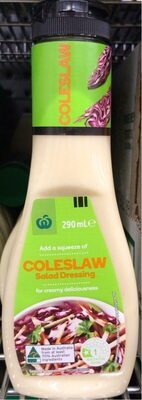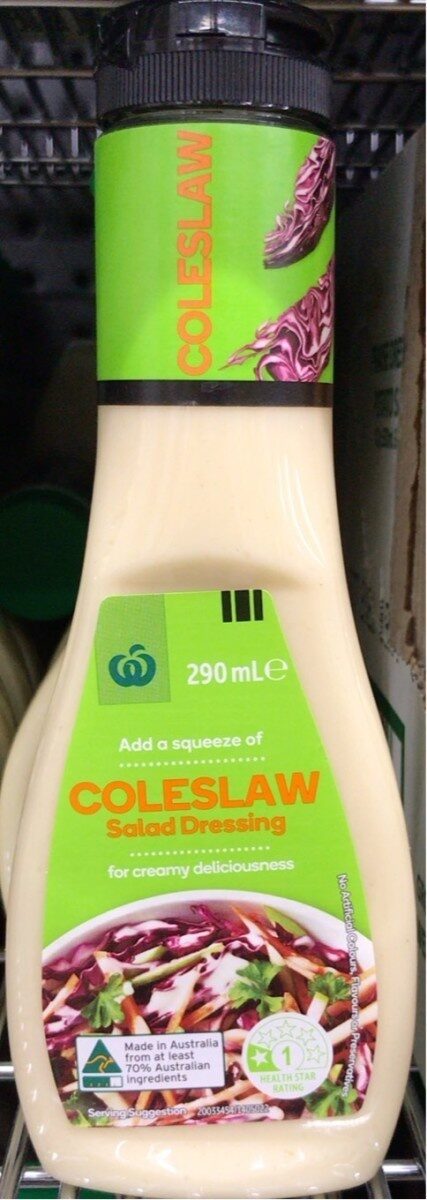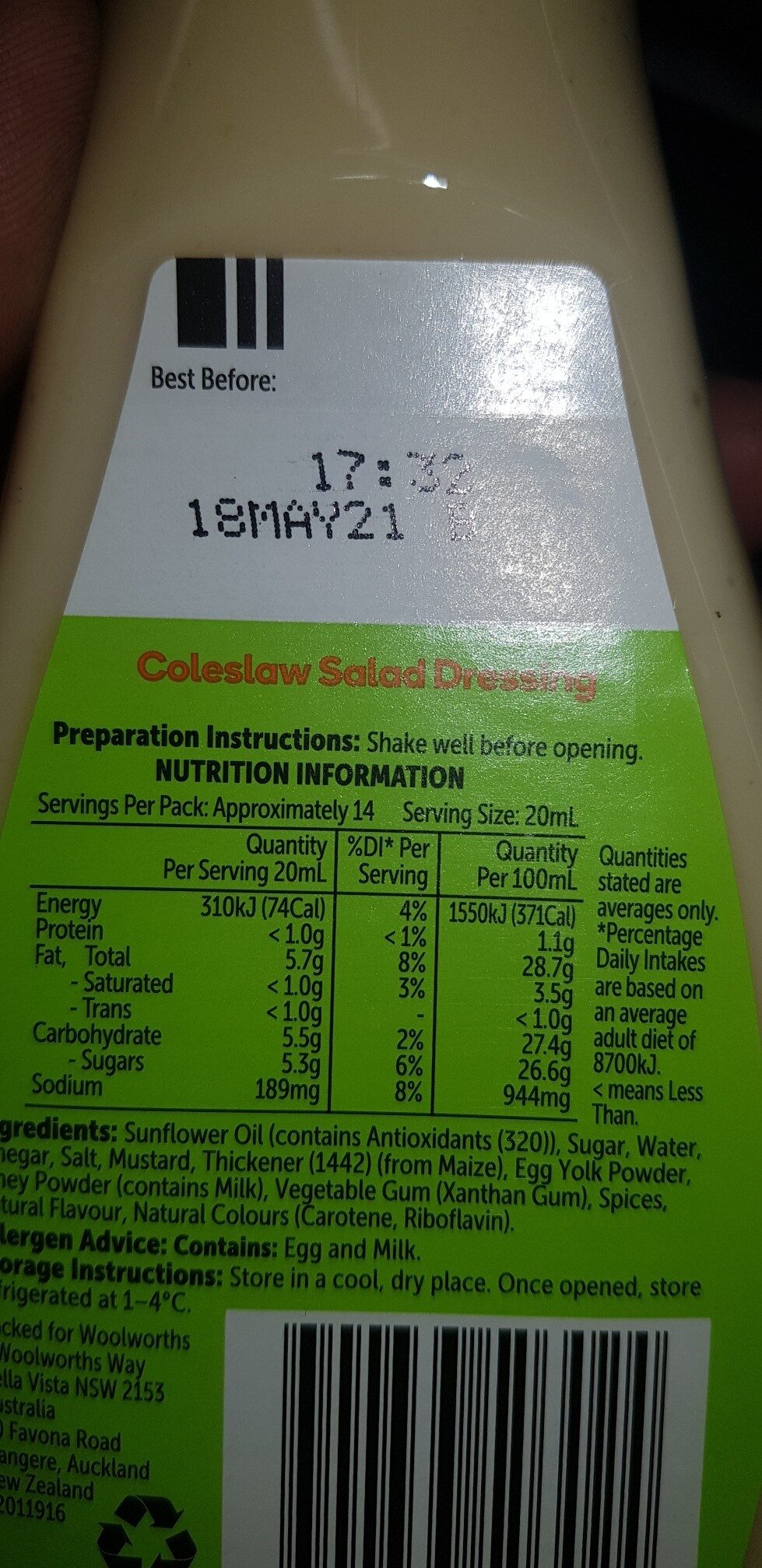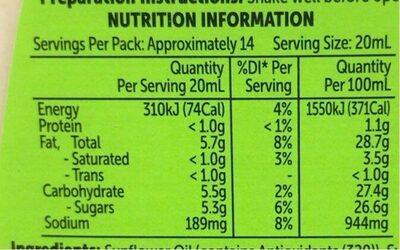Help us make food transparency the norm!
As a non-profit organization, we depend on your donations to continue informing consumers around the world about what they eat.
The food revolution starts with you!
Coleslaw salad dressing - Woolworths - 290 ml
Coleslaw salad dressing - Woolworths - 290 ml
This product page is not complete. You can help to complete it by editing it and adding more data from the photos we have, or by taking more photos using the app for Android or iPhone/iPad. Thank you!
×
Barcode: 9300633503024 (EAN / EAN-13)
Quantity: 290 ml
Brands: Woolworths
Categories: Condiments, Sauces, Salad dressings, Groceries
Labels, certifications, awards:
Australian made, Health Star Rating, Health Star Rating 1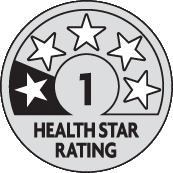
Stores: Woolworths
Countries where sold: Australia
Matching with your preferences
Health
Ingredients
-
38 ingredients
best before: 17:32 18may21 coleslaw sglearess preparation instructions: shake well before opening. nutrition information servings per pack: approximately 14 serving size: 20ml quantity %di* per per serving 20ml serving 310kj (74cal) <1.0g 5.7g <1.0g 1.0g 5.5g 5.3g 189mg quantity quantities per 100ml stated are 4% | 1550kj (371cal) averages only. energy protein fat, total - saturated - trans carbohydrate sugars sodium < 1% 8% 3% 1.1g percentage daily intakes 28.7g are based on 3.5g an average <1.0g adult diet of 27.4g 2% 6% 8% 8700kj. 26.6g 944mg < means less than. gredients: sunflower oil (contains antioxidants (320)), sugar, water, negar, salt, mustard, thickener (1442) (from maize), egg yolk powder, ney powder (contains milk), vegetable gum (xanthan gum), spices, tural flavour, natural colours (carotene, riboflavin). lergen advice: contains: egg and milk. orage instructions:Allergens: Eggs, Milk, Mustard
Food processing
-
Ultra processed foods
Elements that indicate the product is in the 4 - Ultra processed food and drink products group:
- Additive: E101 - Riboflavin
- Additive: E1442 - Hydroxypropyl distarch phosphate
- Additive: E160a - Carotene
- Additive: E415 - Xanthan gum
- Ingredient: Colour
- Ingredient: Thickener
Food products are classified into 4 groups according to their degree of processing:
- Unprocessed or minimally processed foods
- Processed culinary ingredients
- Processed foods
- Ultra processed foods
The determination of the group is based on the category of the product and on the ingredients it contains.
Additives
-
E101 - Riboflavin
Riboflavin: Riboflavin, also known as vitamin B2, is a vitamin found in food and used as a dietary supplement. Food sources include eggs, green vegetables, milk and other dairy product, meat, mushrooms, and almonds. Some countries require its addition to grains. As a supplement it is used to prevent and treat riboflavin deficiency and prevent migraines. It may be given by mouth or injection.It is nearly always well tolerated. Normal doses are safe during pregnancy. Riboflavin is in the vitamin B group. It is required by the body for cellular respiration.Riboflavin was discovered in 1920, isolated in 1933, and first made in 1935. It is on the World Health Organization's List of Essential Medicines, the most effective and safe medicines needed in a health system. Riboflavin is available as a generic medication and over the counter. In the United States a month of supplements costs less than 25 USD.Source: Wikipedia
-
E101i - Riboflavin
Riboflavin: Riboflavin, also known as vitamin B2, is a vitamin found in food and used as a dietary supplement. Food sources include eggs, green vegetables, milk and other dairy product, meat, mushrooms, and almonds. Some countries require its addition to grains. As a supplement it is used to prevent and treat riboflavin deficiency and prevent migraines. It may be given by mouth or injection.It is nearly always well tolerated. Normal doses are safe during pregnancy. Riboflavin is in the vitamin B group. It is required by the body for cellular respiration.Riboflavin was discovered in 1920, isolated in 1933, and first made in 1935. It is on the World Health Organization's List of Essential Medicines, the most effective and safe medicines needed in a health system. Riboflavin is available as a generic medication and over the counter. In the United States a month of supplements costs less than 25 USD.Source: Wikipedia
-
E1442 - Hydroxypropyl distarch phosphate
Hydroxypropyl distarch phosphate: Hydroxypropyl distarch phosphate -HDP- is a modified resistant starch. It is currently used as a food additive -INS number 1442-. It is approved for use in the European Union -listed as E1442-, the United States, Australia, Taiwan, and New Zealand.Source: Wikipedia
-
E160a - Carotene
Carotene: The term carotene -also carotin, from the Latin carota, "carrot"- is used for many related unsaturated hydrocarbon substances having the formula C40Hx, which are synthesized by plants but in general cannot be made by animals -with the exception of some aphids and spider mites which acquired the synthesizing genes from fungi-. Carotenes are photosynthetic pigments important for photosynthesis. Carotenes contain no oxygen atoms. They absorb ultraviolet, violet, and blue light and scatter orange or red light, and -in low concentrations- yellow light. Carotenes are responsible for the orange colour of the carrot, for which this class of chemicals is named, and for the colours of many other fruits, vegetables and fungi -for example, sweet potatoes, chanterelle and orange cantaloupe melon-. Carotenes are also responsible for the orange -but not all of the yellow- colours in dry foliage. They also -in lower concentrations- impart the yellow coloration to milk-fat and butter. Omnivorous animal species which are relatively poor converters of coloured dietary carotenoids to colourless retinoids have yellowed-coloured body fat, as a result of the carotenoid retention from the vegetable portion of their diet. The typical yellow-coloured fat of humans and chickens is a result of fat storage of carotenes from their diets. Carotenes contribute to photosynthesis by transmitting the light energy they absorb to chlorophyll. They also protect plant tissues by helping to absorb the energy from singlet oxygen, an excited form of the oxygen molecule O2 which is formed during photosynthesis. β-Carotene is composed of two retinyl groups, and is broken down in the mucosa of the human small intestine by β-carotene 15‚15'-monooxygenase to retinal, a form of vitamin A. β-Carotene can be stored in the liver and body fat and converted to retinal as needed, thus making it a form of vitamin A for humans and some other mammals. The carotenes α-carotene and γ-carotene, due to their single retinyl group -β-ionone ring-, also have some vitamin A activity -though less than β-carotene-, as does the xanthophyll carotenoid β-cryptoxanthin. All other carotenoids, including lycopene, have no beta-ring and thus no vitamin A activity -although they may have antioxidant activity and thus biological activity in other ways-. Animal species differ greatly in their ability to convert retinyl -beta-ionone- containing carotenoids to retinals. Carnivores in general are poor converters of dietary ionone-containing carotenoids. Pure carnivores such as ferrets lack β-carotene 15‚15'-monooxygenase and cannot convert any carotenoids to retinals at all -resulting in carotenes not being a form of vitamin A for this species-; while cats can convert a trace of β-carotene to retinol, although the amount is totally insufficient for meeting their daily retinol needs.Source: Wikipedia
-
E320 - Butylated hydroxyanisole (bha)
Butylated hydroxyanisole: Butylated hydroxyanisole -BHA- is an antioxidant consisting of a mixture of two isomeric organic compounds, 2-tert-butyl-4-hydroxyanisole and 3-tert-butyl-4-hydroxyanisole. It is prepared from 4-methoxyphenol and isobutylene. It is a waxy solid used as a food additive with the E number E320. The primary use for BHA is as an antioxidant and preservative in food, food packaging, animal feed, cosmetics, rubber, and petroleum products. BHA also is commonly used in medicines, such as isotretinoin, lovastatin, and simvastatin, among others.Source: Wikipedia
-
E415 - Xanthan gum
Xanthan gum (E415) is a natural polysaccharide derived from fermented sugars, often used in the food industry as a thickening and stabilizing agent.
This versatile food additive enhances texture and prevents ingredient separation in a wide range of products, including salad dressings, sauces, and gluten-free baked goods.
It is considered safe for consumption even at high intake amounts.
Ingredients analysis
-
May contain palm oil
Ingredients that may contain palm oil: E160a
-
Non-vegan
Non-vegan ingredients: Egg yolk powderSome ingredients could not be recognized.
We need your help!
You can help us recognize more ingredients and better analyze the list of ingredients for this product and others:
- Edit this product page to correct spelling mistakes in the ingredients list, and/or to remove ingredients in other languages and sentences that are not related to the ingredients.
- Add new entries, synonyms or translations to our multilingual lists of ingredients, ingredient processing methods, and labels.
If you would like to help, join the #ingredients channel on our Slack discussion space and/or learn about ingredients analysis on our wiki. Thank you!
-
Vegetarian status unknown
Unrecognized ingredients: Best-before, 17, 32-18may21-coleslaw-sglearess-preparation-instructions, Shake-well-before-opening, Nutrition-information-servings-per-pack, Approximately-14-serving-size, Quantity-di-per-per-serving-20ml-serving-310kj, 74cal, Quantity-quantities-per-100ml-stated-are-4-1550kj, 371cal, Averages-only, Energy-protein-fat, Total, Saturated, Trans-carbohydrate-sugars-sodium-1-8-3-1-1g-percentage-daily-intakes-28-7g-are-based-on-3-5g-an-average-1-0g-adult-diet-of-27-4g-2-6-8-8700kj, Means-less-than, Gredients, 320, Negar, Mustard, 1442, Ney-powder, Vegetable-gum, Tural-flavour, Orage-instructionsSome ingredients could not be recognized.
We need your help!
You can help us recognize more ingredients and better analyze the list of ingredients for this product and others:
- Edit this product page to correct spelling mistakes in the ingredients list, and/or to remove ingredients in other languages and sentences that are not related to the ingredients.
- Add new entries, synonyms or translations to our multilingual lists of ingredients, ingredient processing methods, and labels.
If you would like to help, join the #ingredients channel on our Slack discussion space and/or learn about ingredients analysis on our wiki. Thank you!
-
Details of the analysis of the ingredients
We need your help!
Some ingredients could not be recognized.
We need your help!
You can help us recognize more ingredients and better analyze the list of ingredients for this product and others:
- Edit this product page to correct spelling mistakes in the ingredients list, and/or to remove ingredients in other languages and sentences that are not related to the ingredients.
- Add new entries, synonyms or translations to our multilingual lists of ingredients, ingredient processing methods, and labels.
If you would like to help, join the #ingredients channel on our Slack discussion space and/or learn about ingredients analysis on our wiki. Thank you!
: best before (17), 32 18may21 coleslaw sglearess preparation instructions (shake well before opening, nutrition information servings per pack), approximately 14 serving size (quantity %di* per per serving 20ml serving 310kj (74cal), quantity quantities per 100ml stated are 4% | 1550kj (371cal), averages only, energy protein fat), total, saturated, trans carbohydrate sugars sodium < 1% 8% 3% 1.1g percentage daily intakes 28.7g are based on 3.5g an average <1.0g adult diet of 27.4g 2% 6% 8% 8700kj, < means less than, gredients (sunflower oil (contains antioxidants (320))), sugar, water, negar, salt, mustard, thickener (1442, from maize), egg yolk powder, ney powder, vegetable gum (xanthan gum), spices, tural flavour, natural colours (carotene, riboflavin), orage instructions- best before -> en:best-before - percent_min: 4.76190476190476 - percent_max: 100
- 17 -> en:17 - percent_min: 4.76190476190476 - percent_max: 100
- 32 18may21 coleslaw sglearess preparation instructions -> en:32-18may21-coleslaw-sglearess-preparation-instructions - percent_min: 0 - percent_max: 50
- shake well before opening -> en:shake-well-before-opening - percent_min: 0 - percent_max: 50
- nutrition information servings per pack -> en:nutrition-information-servings-per-pack - percent_min: 0 - percent_max: 25
- approximately 14 serving size -> en:approximately-14-serving-size - percent_min: 0 - percent_max: 33.3333333333333
- quantity %di* per per serving 20ml serving 310kj -> en:quantity-di-per-per-serving-20ml-serving-310kj - percent_min: 0 - percent_max: 33.3333333333333
- 74cal -> en:74cal - percent_min: 0 - percent_max: 33.3333333333333
- quantity quantities per 100ml stated are 4% | 1550kj -> en:quantity-quantities-per-100ml-stated-are-4-1550kj - percent_min: 0 - percent_max: 16.6666666666667
- 371cal -> en:371cal - percent_min: 0 - percent_max: 16.6666666666667
- averages only -> en:averages-only - percent_min: 0 - percent_max: 11.1111111111111
- energy protein fat -> en:energy-protein-fat - percent_min: 0 - percent_max: 8.33333333333333
- quantity %di* per per serving 20ml serving 310kj -> en:quantity-di-per-per-serving-20ml-serving-310kj - percent_min: 0 - percent_max: 33.3333333333333
- total -> en:total - percent_min: 0 - percent_max: 25
- saturated -> en:saturated - percent_min: 0 - percent_max: 20
- trans carbohydrate sugars sodium < 1% 8% 3% 1.1g percentage daily intakes 28.7g are based on 3.5g an average <1.0g adult diet of 27.4g 2% 6% 8% 8700kj -> en:trans-carbohydrate-sugars-sodium-1-8-3-1-1g-percentage-daily-intakes-28-7g-are-based-on-3-5g-an-average-1-0g-adult-diet-of-27-4g-2-6-8-8700kj - percent_min: 0 - percent_max: 16.6666666666667
- < means less than -> en:means-less-than - percent_min: 0 - percent_max: 14.2857142857143
- gredients -> en:gredients - percent_min: 0 - percent_max: 12.5
- sunflower oil -> en:sunflower-oil - vegan: yes - vegetarian: yes - from_palm_oil: no - ciqual_food_code: 17440 - percent_min: 0 - percent_max: 12.5
- contains antioxidants -> en:antioxidant - percent_min: 0 - percent_max: 12.5
- 320 -> en:320 - percent_min: 0 - percent_max: 12.5
- contains antioxidants -> en:antioxidant - percent_min: 0 - percent_max: 12.5
- sunflower oil -> en:sunflower-oil - vegan: yes - vegetarian: yes - from_palm_oil: no - ciqual_food_code: 17440 - percent_min: 0 - percent_max: 12.5
- sugar -> en:sugar - vegan: yes - vegetarian: yes - ciqual_proxy_food_code: 31016 - percent_min: 0 - percent_max: 11.1111111111111
- water -> en:water - vegan: yes - vegetarian: yes - ciqual_food_code: 18066 - percent_min: 0 - percent_max: 10
- negar -> en:negar - percent_min: 0 - percent_max: 9.09090909090909
- salt -> en:salt - vegan: yes - vegetarian: yes - ciqual_food_code: 11058 - percent_min: 0 - percent_max: 2.3625
- mustard -> en:mustard - ciqual_food_code: 11013 - percent_min: 0 - percent_max: 2.3625
- thickener -> en:thickener - percent_min: 0 - percent_max: 2.3625
- 1442 -> en:1442 - percent_min: 0 - percent_max: 2.3625
- from maize -> en:corn - vegan: yes - vegetarian: yes - ciqual_food_code: 9200 - percent_min: 0 - percent_max: 1.18125
- egg yolk powder -> en:egg-yolk-powder - vegan: no - vegetarian: yes - ciqual_food_code: 22003 - percent_min: 0 - percent_max: 2.3625
- ney powder -> en:ney-powder - percent_min: 0 - percent_max: 2.3625
- vegetable gum -> en:vegetable-gum - percent_min: 0 - percent_max: 2.3625
- xanthan gum -> en:e415 - vegan: yes - vegetarian: yes - percent_min: 0 - percent_max: 2.3625
- spices -> en:spice - vegan: yes - vegetarian: yes - percent_min: 0 - percent_max: 2.3625
- tural flavour -> en:tural-flavour - percent_min: 0 - percent_max: 2.3625
- natural colours -> en:natural-colours - percent_min: 0 - percent_max: 2.3625
- carotene -> en:e160a - vegan: maybe - vegetarian: maybe - from_palm_oil: maybe - percent_min: 0 - percent_max: 2.3625
- riboflavin -> en:e101 - vegan: maybe - vegetarian: yes - percent_min: 0 - percent_max: 1.18125
- orage instructions -> en:orage-instructions - percent_min: 0 - percent_max: 2.3625
Nutrition
-
Bad nutritional quality
⚠ ️Warning: the amount of fiber is not specified, their possible positive contribution to the grade could not be taken into account.⚠ ️Warning: the amount of fruits, vegetables and nuts is not specified on the label, it was estimated from the list of ingredients: 0This product is not considered a beverage for the calculation of the Nutri-Score.
Positive points: 0
- Proteins: 3 / 5 (value: 5, rounded value: 5)
- Fiber: 0 / 5 (value: 0, rounded value: 0)
- Fruits, vegetables, nuts, and colza/walnut/olive oils: 0 / 5 (value: 0, rounded value: 0)
Negative points: 23
- Energy: 4 / 10 (value: 1548, rounded value: 1548)
- Sugars: 5 / 10 (value: 26.5, rounded value: 26.5)
- Saturated fat: 4 / 10 (value: 5, rounded value: 5)
- Sodium: 10 / 10 (value: 945, rounded value: 945)
The points for proteins are not counted because the negative points are greater or equal to 11.
Nutritional score: (23 - 0)
Nutri-Score:
-
Nutrient levels
-
Fat in high quantity (28.5%)
What you need to know- A high consumption of fat, especially saturated fats, can raise cholesterol, which increases the risk of heart diseases.
Recommendation: Limit the consumption of fat and saturated fat- Choose products with lower fat and saturated fat content.
-
Saturated fat in moderate quantity (5%)
What you need to know- A high consumption of fat, especially saturated fats, can raise cholesterol, which increases the risk of heart diseases.
Recommendation: Limit the consumption of fat and saturated fat- Choose products with lower fat and saturated fat content.
-
Sugars in high quantity (26.5%)
What you need to know- A high consumption of sugar can cause weight gain and tooth decay. It also augments the risk of type 2 diabetes and cardio-vascular diseases.
Recommendation: Limit the consumption of sugar and sugary drinks- Sugary drinks (such as sodas, fruit beverages, and fruit juices and nectars) should be limited as much as possible (no more than 1 glass a day).
- Choose products with lower sugar content and reduce the consumption of products with added sugars.
-
Salt in high quantity (2.36%)
What you need to know- A high consumption of salt (or sodium) can cause raised blood pressure, which can increase the risk of heart disease and stroke.
- Many people who have high blood pressure do not know it, as there are often no symptoms.
- Most people consume too much salt (on average 9 to 12 grams per day), around twice the recommended maximum level of intake.
Recommendation: Limit the consumption of salt and salted food- Reduce the quantity of salt used when cooking, and don't salt again at the table.
- Limit the consumption of salty snacks and choose products with lower salt content.
-
-
Nutrition facts
Nutrition facts As sold
for 100 g / 100 mlCompared to: Salad dressings Energy 1,548 kj
(370 kcal)+11% Fat 28.5 g -7% Saturated fat 5 g +27% Carbohydrates 27.5 g +102% Sugars 26.5 g +174% Fiber ? Proteins 5 g +155% Salt 2.362 g +61% Fruits‚ vegetables‚ nuts and rapeseed‚ walnut and olive oils (estimate from ingredients list analysis) 0 %
Environment
-
Eco-Score D - High environmental impact
⚠ ️The full impact of transportation to your country is currently unknown.The Eco-Score is an experimental score that summarizes the environmental impacts of food products.→ The Eco-Score was initially developped for France and it is being extended to other European countries. The Eco-Score formula is subject to change as it is regularly improved to make it more precise and better suited to each country.Life cycle analysis
-
Average impact of products of the same category: C (Score: 54/100)
Category: Salad dressing, prepacked
Category: Salad dressing, prepacked
- PEF environmental score: 0.50 (the lower the score, the lower the impact)
- including impact on climate change: 3.01 kg CO2 eq/kg of product
Stage Impact Agriculture
72.4 %Processing
13.6 %Packaging
5.3 %Transportation
6.3 %Distribution
1.9 %Consumption
0.5 %
Bonuses and maluses
-
Missing origins of ingredients information
Malus:
⚠ ️ The origins of the ingredients of this product are not indicated.
If they are indicated on the packaging, you can modify the product sheet and add them.
If you are the manufacturer of this product, you can send us the information with our free platform for producers.
-
Missing packaging information for this product
Malus: -15
⚠ ️ The information about the packaging of this product is not filled in.⚠ ️ For a more precise calculation of the Eco-Score, you can modify the product page and add them.
If you are the manufacturer of this product, you can send us the information with our free platform for producers.
Eco-Score for this product
-
Impact for this product: D (Score: 34/100)
Product: Coleslaw salad dressing - Woolworths - 290 ml
Life cycle analysis score: 54
Sum of bonuses and maluses: -15
Final score: 34/100
-
Carbon footprint
-
Equal to driving 1.6 km in a petrol car
301 g CO² per 100g of product
The carbon emission figure comes from ADEME's Agribalyse database, for the category: Salad dressing, prepacked (Source: ADEME Agribalyse Database)
Stage Impact Agriculture
65.3 %Processing
13.0 %Packaging
8.0 %Transportation
12.2 %Distribution
1.3 %Consumption
0.2 %
Packaging
-
Missing packaging information for this product
⚠ ️ The information about the packaging of this product is not filled in.Take a photo of the recycling information Take a photo of the recycling information
Transportation
-
Origins of ingredients
Missing origins of ingredients information
⚠ ️ The origins of the ingredients of this product are not indicated.
If they are indicated on the packaging, you can modify the product sheet and add them.
If you are the manufacturer of this product, you can send us the information with our free platform for producers.Add the origins of ingredients for this product Add the origins of ingredients for this product
Report a problem
-
Incomplete or incorrect information?
Category, labels, ingredients, allergens, nutritional information, photos etc.
If the information does not match the information on the packaging, please complete or correct it. Open Food Facts is a collaborative database, and every contribution is useful for all.
Data sources
Product added on by inf
Last edit of product page on by roboto-app.
Product page also edited by archanox, charlesnepote, ecoscore-impact-estimator, kiliweb, naruyoko, teolemon, yuka.sY2b0xO6T85zoF3NwEKvlldicvqHqWvHKhHuq0qi1o6ECJ-4PNdj85PHK6g.
